Thoughtful Gift Ideas for a One-Year-Old's Birthday


Intro
Selecting a gift for a one-year-old can be a challenging task. At this age, children begin to explore their surroundings and start developing preferences. Understanding their developmental stages is key. It ensures that the gifts chosen are not only enjoyable but also beneficial to their growth. This article aims to provide a thorough guide to selecting suitable gifts that engage a child's curiosity while aligning with safety standards.
Gift categories such as educational toys, creative playthings, practical items, and unique ideas will be discussed. Each category offers a different way to support the child's development. Emphasis will be placed on how these gifts can enrich their experiences in a meaningful way. Thus, this guide serves as a resource for parents and gift givers alike.
Prelude to One-Year-Old Gift Selection
When considering a gift for a one-year-old's birthday, it is crucial to understand that this age marks a significant developmental phase. Children at this age are exploring their environment, developing motor skills, and beginning to engage in social interactions. Selecting the right gift is not just about providing entertainment; it is about fostering growth and supporting healthy development.
Choosing appropriate gifts for infants requires careful thought. Gifts that cater to their developmental stage can enhance cognitive abilities, promote physical coordination, and stimulate creative thinking. Parents appreciate gifts that are not only fun but also contribute to their child’s growth.
There are several factors to consider when selecting a gift for a one-year-old. Safety is paramount, as infants tend to explore objects by putting them in their mouths. Therefore, it is essential to choose items that are non-toxic and free from small parts that pose choking hazards. Additionally, the longevity of the gift should be considered. Durable toys that can withstand rough handling are generally favored.
The significance of gift selection at this age extends beyond immediate enjoyment. Thoughtful gifts can help in laying the foundation for future learning. By capturing a child's interest in various activities, gifts can encourage a lifelong love for learning and exploration. Thus, this article aims to provide a comprehensive guide on suitable categories of gifts, emphasizing both developmental relevance and safety.
"A well-chosen gift can enrich a child's play experience, aligning with their developmental milestones and providing both enjoyment and educational value."
This exploration will delve into various types of gifts, ensuring a holistic approach to planning a perfect birthday celebration for the little one.
Significance of Appropriate Gift Choices
Selecting gifts for a one-year-old is more than just a social obligation; it plays a crucial role in the child's early development. At this tender age, the right gifts can stimulate curiosity and enhance fine motor skills while also providing enjoyment. Understanding the significance of gift selection encompasses various aspects—developmental, safety, and even emotional resonance.
When choosing a gift for a one-year-old, it is essential to consider developmental appropriateness. Children at this age are experiencing rapid growth in all areas—cognitive, physical, and emotional. This means that the choice of gifts should align with their developmental milestones, supporting them as they explore their environment. Appropriate gifts can aid in the refinement of sensory abilities and help foster problem-solving skills.
Another vital factor is safety. One-year-olds are notorious for their tendency to put objects in their mouths as a part of exploration. Therefore, selecting gifts that are free from harmful substances and with no small parts is paramount. The safety of a gift is a reflection of thoughtfulness and care. Parents appreciate gifts that show consideration for their child's well-being.
Additionally, considering the emotional connection related to gift-giving is important. Gifts do not solely serve a functional purpose; they are also points of connection. A well-chosen gift can elicit smiles and laughter, contributing to joyous family moments. Gifts that encourage shared playtime can bolster family bonds and create joyful experiences.
In summary, the significance of appropriate gift choices lies in their potential to enhance a child's development while ensuring their safety. Thoughtful gifts also foster emotional connections, enriching family experiences.
In essence, gift selection goes beyond the material object itself. It requires a nuanced understanding of the child's development, the needs and wishes of parents, and the ability to inspire joy, curiosity, and learning. Engaging with these factors not only makes the process rewarding but also ensures that the gesture of giving is meaningful and impactful.
Understanding Developmental Milestones at Age One
Understanding the developmental milestones of a one-year-old is crucial for selecting proper gifts. At this age, infants undergo significant physical, cognitive, and social changes. Recognizing these milestones helps in choosing toys and items that promote growth and encourage learning.
Key Developmental Milestones
Around the first birthday, many children display remarkable achievements. Here are some common milestones:
- Gross motor skills: Children typically begin walking or demonstrate improved mobility like crawling. They may pull themselves up and stand unassisted.
- Fine motor skills: A one-year-old may start to manipulate small objects, grasp toys with purpose, and transfer items from one hand to the other.
- Language development: While word usage is often limited, infants will understand simple instructions and might start saying one or two words.
- Social interaction: Children begin showing preferences for certain people and may exhibit attachment to caregivers.
Benefits of Recognizing Milestones
Selecting gifts that align with these development stages offers several advantages. For instance, educational toys encourage cognitive growth, while physical toys help refine motor skills. Here are some benefits:


- Promotes Development: Toys that challenge a child's abilities foster essential skills. For example, stacking toys enhance fine motor skills while improving hand-eye coordination.
- Encourages Engagement: Age-appropriate gifts keep children engaged for more extended periods. Engaged infants explore and learn, which is key to development.
- Boosts Confidence: Successfully using a new toy increases a child's confidence. They feel a sense of accomplishment as they master new skills.
Considerations for Gift Selection
When choosing a gift, consider the preferences and stage of development of the child. A good gift should:
- Challenge but not frustrate: Select options that encourage growth without overwhelming the toddler.
- Be safe and durable: Quality construction ensures that toys can endure rough play and are safe for exploration.
- Foster curiosity: Gifts should encourage exploration and inquiry, prompting discussions and interactive play with parents.
"Gifts that promote growth and learning align with children's developmental needs, ensuring a joyful experience."
Safety Considerations in Gift Selection
When selecting gifts for a one-year-old, safety is paramount. At this tender age, children are naturally curious and tend to explore their surroundings by putting objects in their mouths. Thus, it is crucial to consider not just the appeal of a gift, but also how it may affect a child’s safety.
Key Elements to Consider
- Material Safety: Ensure that the materials used in the toy are non-toxic and free from harmful chemicals. Many products nowadays state they are BPA-free or phthalate-free. It’s wise to look for certifications that indicate safety, such as the American Society for Testing and Materials (ASTM) or the Consumer Product Safety Commission (CPSC) marks.
- Choking Hazards: Avoid items with small parts that can be easily detached. One-year-olds tend to put everything in their mouths, and even small toys or pieces can pose serious choking risks. Ideally, gifts should be larger than a toilet paper tube to minimize this risk.
- Durability: Toys should withstand the rough and tumble of toddler play. Fragile items that break easily should be avoided. Look for toys constructed from sturdy materials that can endure frequent handling and rough use.
- No Sharp Edges: Ensure that the edges of the toys are rounded and smooth. Toys with sharp edges can cause cuts and injuries, especially if a child falls or tumbles while playing.
- Age Appropriateness: Labels often indicate age recommendations. Following these guidelines is essential to ensure the toy matches the developmental skills and abilities of a one-year-old.
Benefits of Prioritizing Safety
Focusing on safety when selecting gifts not only protects the child but also provides peace of mind for the parents. Parents are more likely to appreciate a thoughtful gift that prioritizes their child's well-being. Therefore, safety can also enhance the perceived value of the gift.
Furthermore, safe toys offer more opportunities for creative and educational play without the worry of accidents. For example, using toys that promote fine motor skills while adhering to safety standards gives parents confidence in their selection.
"Safety should never be an afterthought when choosing gifts for young children. It is a fundamental element of thoughtful gift-giving."
In summary, emphasizing safety in gift selection for one-year-olds is of utmost importance. It encompasses material safety, choking hazards, durability, absence of sharp edges, and age appropriateness. By focusing on these aspects, parents can ensure that the gifts they give provide joy without compromising safety.
Categories of Gifts for One-Year-Olds
Selecting the right gift for a one-year-old is pivotal in supporting their growth and development. At this age, children are highly curious and receptive to new experiences. Therefore, categorizing gifts can be immensely beneficial in ensuring choices are appropriate and enriching. This section unpacks key categories of gifts that cater to a child's evolving needs, while maintaining safety and engagement as primary considerations.
Educational Toys
Benefits of Early Learning Tools
Early learning tools stimulate cognitive development. Engaging with educational toys encourages problem-solving skills and critical thinking in infants. These toys often involve shapes, colors, and sounds that capture a child's attention. Furthermore, they promote hands-on learning, which is essential at this age. An important characteristic of these toys is their capacity to grow with the child. For instance, a simple shape sorter can introduce the concept of shapes and later evolve into more advanced discussions about colors or counting. This layered learning aspect makes it a popular choice. However, it is crucial to select age-appropriate tools to avoid frustration.
Popular Educational Toy Brands
Several brands specialize in creating high-quality educational toys. Brands like Fisher-Price and VTech are known for their focus on developmental appropriateness. These companies design products with engaging aesthetics and features that foster skill development. The unique aspect of these brands is their established reputation for safety and quality. They often conduct extensive testing, thereby ensuring their products are suitable for young children. Despite their slightly higher price point, the investment in reliable educational toys can yield significant developmental benefits for infants.
Creative Playthings
Types of Creative Play Items
Creative play items encompass a wide range of toys designed to inspire imagination. Blocks, dolls, and musical instruments are excellent examples of such toys. They allow infants to engage in free play, reinforcing creativity through exploration. The key characteristic of these items is their versatility; they can be used in various ways, encouraging children to think outside the box. However, it is essential to choose durable items that can withstand the rough and tumble of play.


Role of Imagination in Development
Imagination plays a fundamental role in a child's early development. It not only enhances creativity but also supports social and emotional growth. When one-year-olds indulge in imaginative play, they learn to navigate various scenarios, which centers on role-play. Such play encourages empathy and understanding of the world around them, making it a critical aspect of their learning journey. Promoting this kind of play through thoughtfully selected toys can provide unique developmental advantages.
Practical Gifts
Choosing Functional Baby Gear
Functional baby gear is essential for addressing daily needs. Items like diapers, clothing, and feeding gear often serve a practical purpose. Although these might seem mundane, they can significantly ease the daily routines of parents. The key characteristic here is usefulness; these gifts support the child's daily activities while providing convenience for caregivers. Moreover, selecting high-quality gear often results in long-term savings.
Value of Everyday Essentials
Everyday essentials are more than just basic items; they are critical in facilitating the baby’s day-to-day activities. Practical gifts can include storage solutions for toys or educational materials. By incorporating these essentials, caregivers can foster organization and responsibility in a child’s environment. The distinctive feature of everyday essentials is their ability to blend functionality with utility, allowing parents to introduce children to responsible habits at a young age.
Unique and Memorable Gifts
Personalized Gifts for Infants
Personalized gifts hold a special place in the realm of gift-giving. Items can be customized with the child’s name or birth date, adding sentimental value. This unique feature creates lasting memories for both the giver and receiver. There is a warmth in giving something that has been specially made for the child, making it a thoughtful choice. However, one must ensure such gifts are safe for infants and not overly complex to avoid hazards.
Experiential Gifts for Families
Experiential gifts offer a chance to create cherished memories. These may include tickets to children's events or memberships to museums or zoos. The essence of these gifts lies not only in enjoyment but also in the shared experiences that families can have together. They foster bonding and create moments that will be treasured as the child grows. However, such gifts should be easily accessible and suitable for infants to ensure a positive experience.
Curating a thoughtful selection of gifts that address the unique needs of one-year-olds can significantly influence their early development. It highlights the importance of engagement and appropriateness in each choice.
Gift Trends for One-Year-Olds
In the rapidly evolving world of children's products, understanding gift trends is crucial for selecting the best presents for a one-year-old's birthday. Trends reflect changes in consumer preferences and advancements in knowledge about child development. Gift choices often mirror societal shifts, promoting not just fun, but also growth and mindfulness. In this section, we will explore two major trends: Eco-Friendly Gift Options and Tech Toys for Toddlers. Each subset presents unique opportunities and considerations for gift givers.
Eco-Friendly Gift Options
Growing Demand for Sustainable Products
The call for eco-friendly options in gift selection has grown significantly. Parents today are more aware of their environmental impact. They seek products that are sustainable and safe for their children. This trend enhances overall gift choices by promoting the use of non-toxic materials, recycled packaging, and ethical sourcing practices.
Many eco-conscious gifts feature biodegradable components. This not only reduces waste but also teaches children early lessons about caring for the environment. Parents appreciate brands that align with their values, making these gifts a favorable choice for many.
Brands Focusing on Eco-Conscious Materials
Numerous brands now prioritize environmentally friendly materials. Companies like Green Toys and Bannor Toys exemplify this shift toward sustainability. They offer products made from recycled plastics or sustainably sourced wood. This trend benefits the market by increasing availability and visibility of eco-friendly options. Furthermore, parents can feel confident that these brands have the health of their children, and the planet, in mind.
However, eco-friendly products can sometimes carry a higher price point. This may discourage consumers who are looking for budget-friendly gifts. Yet the value added through sustainability often outweighs such considerations for many discerning buyers.
Tech Toys for Toddlers
Impact of Technology on Development
Technology's role in early childhood development is increasingly significant. Many parents welcome the introduction of tech toys that encourage learning through interactive play. Products that promote problem-solving skills and critical thinking are becoming popular in this category. They assist in cognitive development and can set the stage for future learning.
Specific types of tech toys, such as VTech and LeapFrog, provide educational content that captures children's attention while challenging them mentally. The focus on technology as a developmental tool supports skill acquisition from an early age. However, careful selection is necessary to ensure that screen time is balanced and does not replace traditional play.
Choosing Screen-Free Tech Alternatives


Amid growing awareness of screen time impacts, many parents look for screen-free tech alternatives. These items often include sound-producing toys or devices that serve educational purposes without direct screens. Examples include musical instruments and interactive books. This choice addresses concerns about overstimulation and reliance on screens from an early age. It aligns with a proactive approach to healthy development, allowing children to engage without excessive exposure to screens. The challenge lies in balancing tech benefits with the need for physical play.
In summary, staying attuned to gift trends helps gift givers make informed decisions. Eco-friendliness and tech integration represent two of the most notable trends. Each bears its own set of advantages and considerations, ensuring a thoughtful selection process.
Budget Considerations When Choosing Gifts
Choosing gifts for a one-year-old can be both exciting and overwhelming. While it's easy to get caught up in the joy of selecting something special, budget considerations play a crucial role in ensuring that gifts are meaningful without causing financial strain. With the wide variety of options available today, particularly in stores and online, it’s important to strike a balance between quality and affordability.
When thinking about budget, reflect on a few key elements. First, consider the gifting occasion and whether it’s a solitary gift or part of a group effort. If it’s a larger celebration, pooling resources can lead to getting a higher-value gift without increasing individual spending. Next, evaluate the necessity of the item. Practical gifts, such as diapers or clothing, might not be the most exciting options but often hold more value in their daily use. Moreover, monitoring seasonal sale events or discounts can provide opportunities to purchase high-quality gifts at lower prices, maximizing the impact of your budget.
Benefits of Budgeting for Gifts
- Helps Prioritize Needs: Carefully managing expenses can clarify which gifts are truly worthy.
- Reduces Stress: With a budget in place, you can eliminate worry about overspending.
- Enhances Gifting Experience: It allows for exploration of various options rather than impulsive choices.
Emphasizing budgeting does not compromise the joy of gift-giving. Instead, it enhances the experience, ensuring thoughtful presents tailored to the child’s developmental stage and preferences.
Finding Value in Affordable Options
Identifying affordable options can save both time and money while still providing high-quality gifts. Not every valuable gift must come with a hefty price tag. Many well-crafted toys and essentials are available from budget-friendly brands.
A good starting point is to explore local stores, where sometimes unique finds can be unearthed at reasonable prices. Online marketplaces can also provide various options, allowing for easy comparison and selection based on user reviews. These platforms often have a filtering system that makes finding budget-friendly items simpler.
Some effective techniques include:
- Set a Clear Budget: Before shopping, decide on a firm budget. This helps narrow down options swiftly.
- Look for Reviews: User feedback can guide selection toward gifts that offer more value for less money.
- Consider Buying Second-Hand: Gently used toys can often be just as valuable and more affordable.
"A well-considered gift doesn't need to be expensive to be cherished."
Quality vs. Price Analysis
When selecting gifts within a budget, it is essential to compare quality against price. Investing slightly more in a durable toy can be wiser than opting for multiple cheap items that may break quickly. Over time, some brands are known for their commitment to quality, offering products that withstand the challenges of active one-year-olds.
A thorough analysis should include checking materials used, brand reputation, and safety certifications. Prioritizing items made from non-toxic materials is critical as children at this age often explore via taste. Additionally, some brands might offer a satisfaction guarantee, which is an indicator of the confidence they place in their products.
- Balance Your Focus: Ensure that the selected item meets both quality and developmental needs rather than just focusing on the price.
- Read Product Specifications: Understand the features to determine if the item justifies its cost.
- Trustworthy Brands: Brands like Fisher-Price and Lego Duplo are known for offering good quality for reasonable prices.
Ultimately, the goal should be to find a perfectly balanced object that delights the child while also meeting financial expectations, thereby making informed and thoughtful gifting decisions.
Culmination: Thoughtful Gift Giving
In the journey of selecting gifts for a one-year-old’s birthday, the concluding element is the importance of thoughtful gift giving. This aspect encompasses not just the act of purchasing an item but carefully considering developmental appropriateness, safety, and parental values. The significance lies in the potential impact these gifts have on a young child's initial stage of growth and learning.
As discussed earlier, one-year-olds are in a critical developmental phase, where they explore their environment and begin to understand the world around them. Thus, gifts that align with their milestones can foster essential skills. For instance, choosing educational toys enhances cognitive development. Meanwhile, creative playthings stimulate imagination and innovation. Both types play a significant role in shaping a child's future capabilities.
A thoughtful gift also reflects an understanding of safety concerns. Parents prioritize gifts that are free from harmful materials or small parts that could pose choking hazards. This sensitivity not only addresses safety but also reinforces trust between the giver and the recipient's family.
"Gifting is not just about the item, it's about the intention behind it."
Moreover, the gift should align with family values and expectations. Understanding these can ensure that the gift is well-received and cherished. Practical gifts, such as clothing or baby gear, serve immediate needs while unique gifts can create lasting memories. Hence, it is crucial to think beyond mere trends or fads in gift-giving.
Considering the budget is also a part of thoughtful gifting. It is possible to find quality options without overspending. Striking this balance between affordability and value reflects respect for the recipients’ circumstances, promoting a healthy gifting culture.
In summary, the conclusion emphasizes that thoughtful gift giving is multi-faceted. It requires one to reflect on developmental needs, safety, personal values, and budget considerations. By doing so, not only do you enrich a child’s early experiences, but you also contribute positively to the overall journey of childhood development.







